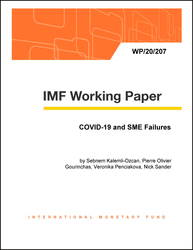
COVID-19 and SME Failures
COVID-19 and SME Failures
READ MORE...
Volume/Issue:
Volume 2020
Issue 207
Publication date: September 2020
ISBN: 9781513557748
$18.00
Add to Cart by clicking price of the language and format you'd like to purchase
Available Languages and Formats
| English |
Prices in red indicate formats that are not yet available but are forthcoming.
Topics covered in this book
This title contains information about the following subjects.
Click on a subject if you would like to see other titles with the same subjects.
Labor , Economics- Macroeconomics , WP , bankruptcy rate , cash flow , wage bill , employment decision , ghost firm , construction company , firm coverage , COVID-19 , Supply shocks , Labor supply , Wages , Global , , coverage ratio , liquidity condition
Summary
We estimate the impact of the COVID-19 crisis on business failures among small and medium size enterprises (SMEs) in seventeen countries using a large representative firm-level database. We use a simple model of firm cost-minimization and measure each firm’s liquidity shortfall during and after COVID-19. Our framework allows for a rich combination of sectoral and aggregate supply, productivity, and demand shocks. We estimate a large increase in the failure rate of SMEs under COVID-19 of nearly 9 percentage points, ab-sent government support. Accommodation & Food Services, Arts, Entertainment & Recreation, Education, and Other Services are among the most affected sectors. The jobs at risk due to COVID-19 related SME business failures represent 3.1 percent of private sector employment. Despite the large impact on business failures and employment, we estimate only moderate effects on the financial sector: the share of Non Performing Loans on bank balance sheets would increase by up to 11 percentage points, representing 0.3 percent of banks’ assets and resulting in a 0.75 percentage point decline in the common equity Tier-1 capital ratio. We evaluate the cost and effectiveness of various policy interventions. The fiscal cost of an intervention that narrowly targets at risk firms can be modest (0.54% of GDP). However, at a similar level of effectiveness, non-targeted subsidies can be substantially more expensive (1.82% of GDP). Our results have important implications for the severity of the COVID-19 recession, the design of policies, and the speed of the recovery.
Copyright © 2010 - 2024
Powered by:
AIDC



